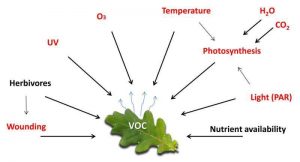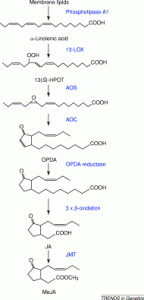Close your eyes and imagine your sun soaked skin embracing the warmth Vancouver has finally blessed you with, the gentle cool breeze dancing through your hair, and your feet standing on top of a luscious, emerald lawn. Go ahead, take a deep breath, the smell of freshly cut grass. The scent of summer.
Why is the scent of freshly cut lawns so pleasant? The answer is pheromones. Plants are able to communicate with each other by sending out pheromones—chemical messengers. Plant cells synthesize these chemical compounds and then release them into the environment to elicit a response in the times of distress.
One of the key chemicals that elicits the defense response in plants is Jasmonic Acid. This organic compound activates the production of other genes for defense.
Methyl Jasmonic Acid is a derivative of jasmonic acid; its role is to regulate the developmental process and defense responses of plants when stress is detected. Part of the defence mechanism is releasing pheromones into the air warning plants around them that danger is near. These pheromones released are organic volatile substances known as Green Leaf Volatile (GLV). They have aldehydes, alcohols, and ester functional groups, which produces that fragrant aroma that people so often associate with summer.

Volatile Organic Compounds Credit: Materic, D. et al. phys.org
Methyl Jasmonic acid is synthesized through the octadecanoid pathway. The picture below shows a detailed reaction pathway to this compound.

Biosynthesis of Methyl Jasmonic Acid Credit: Cheong, J.J. and Choi, Y.D. , Trends in Genetics
Although these volatiles may come from the same or entirely different species, the presence of these chemicals increase defence compounds. When cell membrane receptors detect these volatile chemicals, it activates self-defence by producing toxins, such as proteinase inhibitor. Furthermore, some of these pheromones produced by plants are able to attract insects to help defend themselves. For example, some plants release a certain type of pheromones to attract wasps. These wasps lay their eggs in caterpillars and when these eggs are hatched, the larvae eat the caterpillar from inside out.
I find this defense mechanism of plants absolutely fascinating. Plants are able to defend themselves in certain ways humans and animals cannot. While animals have physical features such as sharp talons or claws, speed, enhanced senses, and humans have martial arts and the sympathetic nervous system that elicits the fight-or-flight response as a form to defense mechanisms, plants defend themselves with the power of chemistry!
So the next time you’re out on a stroll enjoying that summer evening and you hear the roar of your neighbour’s lawnmower, you now know that the fragrant cut grass scent that follows is actually their distress signal. While releasing a series of organic molecules into the air to warn their plant friends and neighbours, it serves as an aromatic treat for us humans.
This video provides a more general explanation of this topic:
Resources:
Reece, J.B. et al. Fundamental of Physiology, 2nd ed.; Pearson: Canada, 2014; pp 237-238.
Cheong, J.J.; Choi, Y.D. Methyl jasmonate as a vital substance in plants. TRENDS in Genetics. [Online] 2013, 7. 409-412. http://www.cell.com/trends/genetics/pdf/S0168-9525(03)00138-0.pdf (accessed Sept 23, 2016)
Phys.org. De-mystifying the Study of Volatile Organic Plant Compounds. http://phys.org/news/2016-01-de-mystifying-volatile-compounds.html (accessed: Sept 24, 2016)


